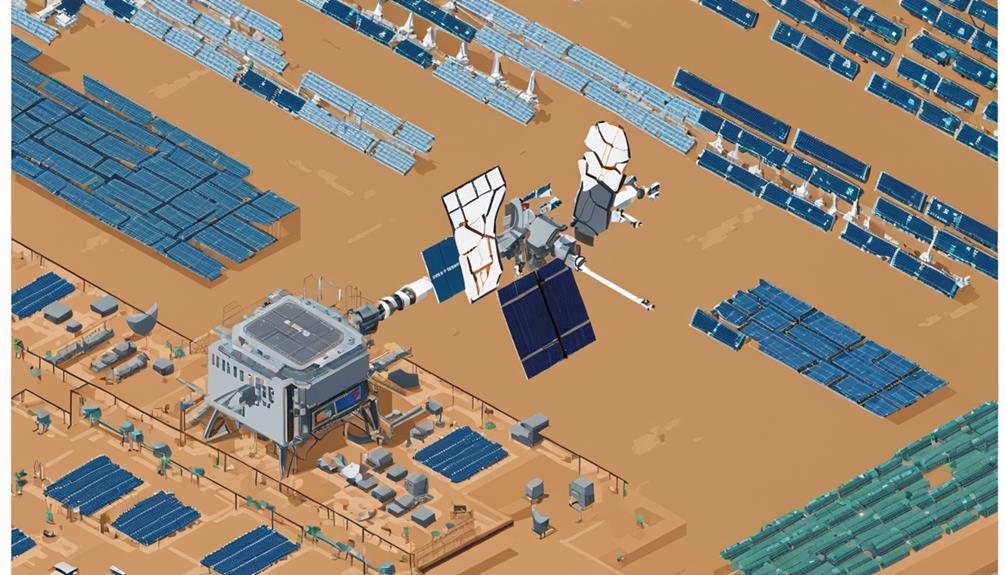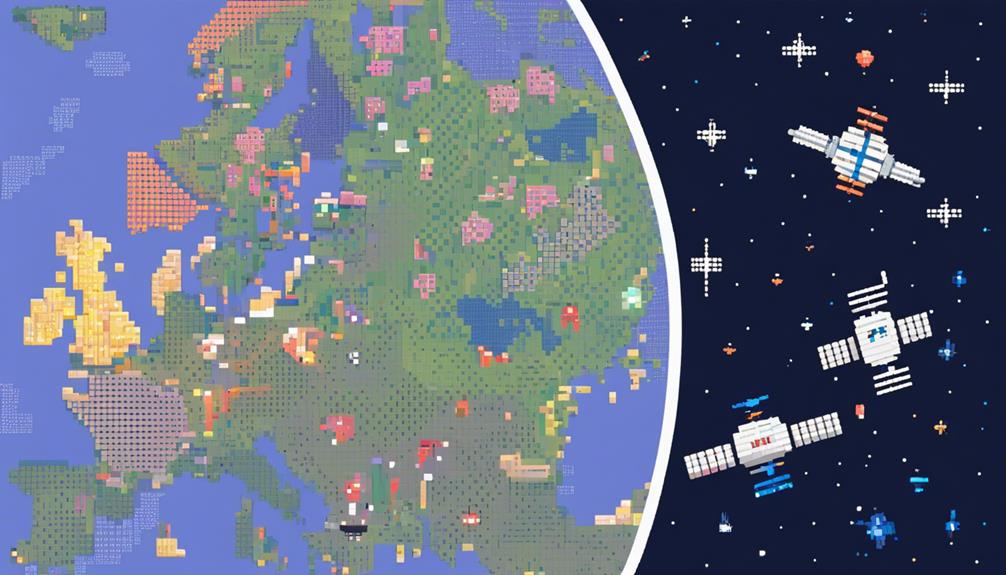In the rapidly evolving landscape of satellite internet technology, companies like Amazon, OneWeb, Telesat, Viasat, Geespace, and even initiatives by the European Union are making significant strides to challenge SpaceX's Starlink. From Amazon Project Kuiper's planned deployment of thousands of satellites to OneWeb's focus on low latency and high-speed connectivity, each competitor brings unique innovations to the table. As the race for superior satellite internet capabilities intensifies, exploring the advancements and breakthroughs by these Starlink rivals promises a deeper insight into the future of global connectivity and technological progress in the cosmos.
Key Takeaways
- Competitors like OneWeb, Telesat, Viasat, and Geespace focus on high-speed internet with advanced satellite constellations.
- Financial commitments and infrastructure utilization demonstrate strong backing and efficient deployment strategies.
- Diverse launch technologies and partnerships highlight unique approaches to satellite deployment in the industry.
- European Union's space initiatives, including Copernicus and Galileo, contribute to comprehensive space projects and research.
Amazon Project Kuiper's Advanced Technology

Amazon Project Kuiper's cutting-edge satellite technology is poised to revolutionize the realm of high-speed internet connectivity with its ambitious plans to deploy over 3,000 satellites for global coverage. Project Kuiper, a venture by Amazon, aims to provide speeds of up to 400 megabits per second to users worldwide, challenging competitors like SpaceX in the satellite internet market. With a commitment of over $10 billion, Amazon is investing heavily in Project Kuiper to establish itself as a formidable player in this space.
Amazon's strategy with Project Kuiper extends beyond satellite deployment. Leveraging its vast global logistics network and Amazon Web Services (AWS) infrastructure, the company plans to optimize satellite coverage efficiently and effectively. By integrating these resources, Amazon aims to ensure seamless connectivity for its satellite internet service, enhancing user experience and service reliability.
The upcoming launch of Project Kuiper's first two prototype satellites marks a significant milestone in Amazon's journey towards providing high-speed internet access globally. These satellites will play a crucial role in testing the capabilities and performance of the service, paving the way for the full-scale deployment of the satellite constellation.
As Amazon Project Kuiper enters the competitive arena of satellite internet services, its technological advancements and strategic approach position it as a key player to watch in the evolving landscape of global connectivity.
OneWeb's Satellite Network Enhancements
With the growing competition in the satellite internet market, OneWeb has strategically enhanced its satellite network to achieve impressive speeds and coverage capabilities. Key enhancements to OneWeb's satellite network include:
- Satellite Constellation: OneWeb plans to launch a total of 648 satellites for its network, with 428 satellites already in orbit. This extensive constellation enables comprehensive coverage and reliable connectivity.
- Speed and Latency: OneWeb has recorded speeds exceeding 400 megabits per second, providing users with high-speed internet access. Additionally, the network boasts low latency of 32 milliseconds, ensuring minimal delays in data transmission.
- User Terminals: OneWeb offers community user terminals priced between $1,000 to $1,500, making access to their network more accessible to a wider range of users. These terminals play a crucial role in connecting end-users to the satellite network.
- Coverage Area Expansion: By the end of 2021, OneWeb aims to extend its coverage to latitudes north of 50 degrees. This expansion demonstrates OneWeb's commitment to increasing its footprint and providing connectivity to more remote regions.
Through these enhancements, OneWeb continues to position itself as a formidable player in the satellite internet market, offering reliable connectivity, high speeds, and broad coverage capabilities to users around the globe.
Telesat's Cutting-Edge Innovations

Telesat's innovative satellite constellations, advanced antennas, and inter-satellite links represent groundbreaking advancements in the field of satellite internet technology. By deploying a mix of geostationary and LEO satellites, Telesat's Lightspeed constellation aims to deliver unprecedented gigabit speeds and minimal latency to business users. The integration of cutting-edge antennas and inter-satellite communication capabilities further solidifies Telesat's position as a formidable competitor in the evolving landscape of satellite internet services.
Telesat's Satellite Constellations
Amidst the evolving landscape of satellite internet technology, Telesat's cutting-edge innovations in satellite constellations stand out for their commitment to delivering gigabit per second speeds and low latency connectivity to businesses worldwide. Telesat's Lightspeed constellation, comprising 1,600 LEO satellites, is set to revolutionize the industry with its advanced capabilities. Here are key points about Telesat's Satellite Constellations:
- Lightspeed Constellation: Telesat's groundbreaking network of 1,600 LEO satellites designed to provide high-speed internet globally.
- LEO Satellites: Deployed in Low Earth Orbit for reduced latency and improved performance.
- Gigabit Speeds: Offering data transfer rates of up to one gigabit per second for efficient connectivity.
- Low Latency Connectivity: Ensuring minimal delays in data transmission for enhanced user experience and operational efficiency.
Telesat's Advanced Antennas
How do Telesat's advanced antennas for the Lightspeed constellation contribute to enhancing global internet connectivity? Telesat's cutting-edge antennas play a pivotal role in providing high-speed, low-latency internet services by enabling gigabit-per-second speeds for users. These advanced antennas showcase Telesat's commitment to efficiency, ensuring reliable connectivity for businesses and individuals. Designed to optimize signal reception and transmission, these antennas significantly enhance the overall performance of Telesat's satellite network. Through this investment in advanced antenna technology, Telesat aligns with its strategic goal of delivering superior quality internet services to its target market. By leveraging these innovative antennas, Telesat aims to revolutionize global connectivity, offering efficient and seamless high-speed internet access to users around the world.
Telesat's Inter-Satellite Links
Utilizing cutting-edge inter-satellite links, Telesat's Lightspeed constellation is poised to revolutionize global internet connectivity through enhanced data transmission capabilities among its 1,600 LEO satellites. This innovative approach by Telesat enables:
- Seamless and rapid data exchange between satellites in the Lightspeed constellation.
- Reduced latency in transmitting data, ensuring quicker response times for internet users.
- Optimization of network efficiency, leading to improved overall performance of satellite internet services.
- Delivery of high-speed connectivity globally, meeting the increasing demands for fast and reliable internet access. Telesat's commitment to leveraging inter-satellite links highlights its dedication to pushing the boundaries of satellite technology and setting new standards in the industry.
Viasat's Next-Generation Solutions

Viasat's next-generation solutions leverage its higher orbit positioning for enhanced satellite internet services, offering a competitive edge in the industry. By focusing on addressing low-Earth orbit congestion concerns, Viasat aims to differentiate itself from Starlink and other competitors. With the launch of Viasat-3 on the horizon, promising significantly improved download speeds, Viasat continues to evolve its technology to meet the demands of high-speed internet users.
Viasat's Latest Technology
Viasat has unveiled its latest technological advancements in satellite internet services, solidifying its position as a formidable competitor in the industry. Viasat's cutting-edge innovations include:
- Viasat-3 Satellite**: Set to revolutionize the industry, Viasat-3 promises exceptional download speeds reaching hundreds of Mbps.
- Higher Orbit Operation: By operating at a higher orbit compared to some competitors, Viasat ensures improved coverage and reduced congestion concerns.
- Enhanced User Experience: With a focus on enhancing user experience, Viasat's new technologies aim to deliver seamless and high-speed internet connectivity.
- Technological Capabilities**: Viasat's fleet of large satellites, such as ViaSat-1, WildBlue1, Anik-F2, and ViaSat-2, underscores the company's robust technological capabilities and commitment to innovation.
Competitive Advantages of Viasat
Operating at a higher orbit compared to some competitors, Viasat leverages this strategic positioning to enhance coverage capabilities and minimize potential congestion issues in the satellite internet market. With its broadband services reaching approximately 590,000 U.S. subscribers, Viasat demonstrates a strong market presence. The upcoming Viasat-3 satellite is anticipated to offer download speeds of up to hundreds of Mbps, indicating significant performance enhancements. Viasat's targeted approach towards delivering services to businesses sets it apart in the industry competition, focusing on meeting specific customer needs. The concern raised by Viasat regarding low-Earth orbit congestion, particularly in comparison to SpaceX's Starlink, underscores the competitive dynamics at play in the satellite internet sector.
Geespace's Revolutionary Satellite Technologies
Geespace, a subsidiary of Chinese auto giant Geely, has successfully launched nine satellites into low Earth orbit as part of its groundbreaking satellite technology initiatives. The company's innovative approach aims to build a constellation of 240 satellites, with a primary focus on transmitting data for Geely's autonomous driving program. This showcases the practical applications of Geespace's satellite technology in real-world scenarios. Additionally, Geespace's CEO has emphasized the importance of partnerships with other industries, highlighting the broad impact of the company's revolutionary satellite technologies.
Key Innovations by Geespace:
- Satellite Technology Advancements: Geespace's satellites leverage cutting-edge technology to operate effectively in low Earth orbit, supporting various applications.
- Data Transmission Solutions: The company excels in transmitting large volumes of data efficiently, crucial for enhancing autonomous driving systems and other data-intensive operations.
- Strategic Partnerships: Geespace collaborates with different sectors to maximize the utility of its satellite technology, fostering innovation and integration across industries.
- High-Tech Solutions Development: Geespace's advancements contribute significantly to the development of high-tech solutions, demonstrating its commitment to pushing the boundaries of satellite technology for diverse sectors.
The European Union's Space Initiatives

The European Union's strategic space initiatives encompass a range of cutting-edge programs and collaborations aimed at advancing Earth observation, satellite navigation, research, and industry competitiveness. The Copernicus program, a cornerstone of these initiatives, provides invaluable Earth observation data for environmental monitoring and disaster management. Complementing Copernicus, the EU's Galileo satellite navigation system stands as a beacon of precise positioning and timing information essential for various civilian applications.
Collaborating closely with EU member states, the European Space Agency (ESA) plays a pivotal role in driving space projects, research endeavors, and exploration missions. Additionally, the EU's Horizon Europe program serves as a financial catalyst for space research and innovation projects, fostering technological advancements that underpin economic growth and sustainability within the European space industry.
In line with enhancing space industry competitiveness, the European Union is actively engaged in the European Space Surveillance and Tracking (SST) program, dedicated to monitoring space debris—a critical aspect of space operations. Through these comprehensive initiatives and strategic partnerships, the European Union solidifies its position as a key player in shaping the future of space exploration and technology.
Advancements in Satellite Internet by Starlink Competitors
Competition in the satellite internet industry intensifies as Starlink faces formidable rivals showcasing significant technological advancements. These competitors are rapidly evolving to provide high-speed internet services and low latency, challenging Starlink's dominance in the market. Here are some notable advancements in satellite internet by Starlink competitors:
- OneWeb: Achieved speeds exceeding 400 megabits per second with a latency of 32 milliseconds, offering competitive performance in the satellite internet sector.
- Viasat: Operating at a higher orbit than SpaceX, Viasat serves approximately 590,000 subscribers in the United States, providing broadband services with widespread coverage.
- Geespace: Launched nine satellites into low Earth orbit, focusing on data transmission for applications like autonomous driving, showcasing a niche focus within the satellite internet market.
- Telesat: Targeting businesses with its Lightspeed constellation, Telesat promises gigabit-per-second speeds and low latency, catering to the needs of enterprise customers requiring reliable and high-speed internet connectivity.
These advancements signify a competitive landscape in the satellite internet industry, with companies like Amazon's Project Kuiper also investing heavily to challenge Starlink's market position. As these competitors continue to innovate and enhance their satellite internet offerings, consumers can expect improved connectivity options and services in the near future.
Launch Technology Innovations in the Satellite Market

In the realm of satellite technology, the launch processes employed by key industry players showcase a strategic amalgamation of cutting-edge innovations and collaborative efforts with established aerospace entities. Various companies have adopted different strategies for satellite launches, leveraging partnerships with renowned launch providers to deploy their constellations into low Earth orbit. Here is a summary of some notable launch technology innovations in the satellite market:
| Company | Launch Provider | Satellite Launches |
|---|---|---|
| OneWeb | Soyuz | Baikonur Cosmodrome, Kazakhstan |
| Telesat | Blue Origin | New Glenn rocket deployment for Lightspeed constellation |
| Viasat | SpaceX | Falcon 9 rockets utilized for satellite launches |
| Geespace | Chinese launch vehicles | Long March series for satellites in low Earth orbit |
| Amazon | Arianespace and others | Agreements with multiple launch providers for Project Kuiper constellation deployment |
These collaborations highlight a trend where satellite internet competitors are working with a diverse range of launch providers to achieve successful rocket deployment and constellation deployment. Such partnerships not only demonstrate the technological advancements in the field but also underline the importance of space partnerships in the competitive satellite market.
Competitive Edge: Amazon Vs. Starlink
With the satellite-internet industry intensifying, Amazon's Project Kuiper and SpaceX's Starlink are engaged in a fierce rivalry for market dominance. Amazon's Project Kuiper aims to challenge Starlink's position with its ambitious plans and strategic advantages. Here are key points highlighting the competitive edge between Amazon's Project Kuiper and SpaceX's Starlink:
- Satellite Constellation Size: Project Kuiper plans to launch 3,236 satellites into orbit, rivaling Starlink's constellation size and aiming to provide extensive coverage for its satellite-internet services.
- Financial Commitment: With a financial commitment exceeding $10 billion, Amazon demonstrates a strong investment in Project Kuiper, showcasing its determination to compete with Starlink on a significant scale.
- Infrastructure Utilization: Leveraging Amazon's global logistics network and AWS infrastructure, Project Kuiper can efficiently deploy and manage its satellite constellation, enhancing its global coverage capabilities.
- Cost and Capacity Advantage: Project Kuiper targets offering better coverage and capacity at a lower cost compared to Starlink, potentially attracting a broader customer base and posing a competitive threat to SpaceX's satellite-internet venture.
Amazon's Project Kuiper's impending commercial service launch in the first half of the next year indicates the rapid progress Amazon is making in the satellite-internet competition against Starlink, setting the stage for an intense battle for global coverage and market supremacy.
Frequently Asked Questions
Who Is the Competitor to Starlink?
OneWeb emerges as a prominent competitor challenging SpaceX's Starlink in the satellite internet industry. With 428 satellites already launched and plans for a total of 648, OneWeb offers speeds exceeding 400 megabits per second and a latency of 32 milliseconds. This competition underscores the intense rivalry in the satellite internet market, emphasizing the significance of global internet connectivity and the ongoing space race in telecommunications.
How Is Oneweb Different From Starlink?
OneWeb differentiates itself from Starlink through its approach to satellite technology. With a focus on global coverage and low latency, OneWeb aims to bridge the digital divide by providing rural connectivity. Engaged in the space race, OneWeb's strategy revolves around deploying a constellation of satellites to offer high-speed internet services worldwide. This unique emphasis on widespread connectivity and reduced latency sets OneWeb apart in the competitive satellite internet market.
How Does Starlink Compare to Other Internet Providers?
When comparing Starlink with other internet providers, factors such as satellite technology, latency, data speeds, coverage areas, pricing models, and customer satisfaction play crucial roles. Starlink distinguishes itself with its advanced satellite technology, offering low latency, high data speeds, global coverage, competitive pricing models, and positive customer satisfaction. These aspects position Starlink as a leading choice in the satellite internet market, providing robust services to users worldwide.
What Is Amazon's Alternative to Starlink?
Amazon's alternative to Starlink is Project Kuiper, a satellite internet service designed to enhance global connectivity. Project Kuiper plans to deploy 3,236 satellites in low Earth orbit, aiming to offer superior coverage and capacity at a competitive cost. Amazon's heavy investment of over $10 billion underscores its ambition to revolutionize broadband competition. Positioned within the space race, Amazon's Kuiper presents innovative connectivity solutions, aligning with CEO Andy Jassy's vision for a transformative impact akin to Amazon Web Services (AWS).
